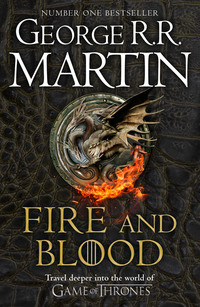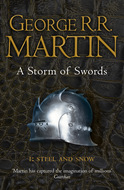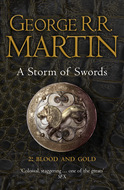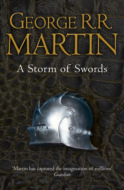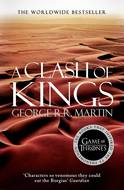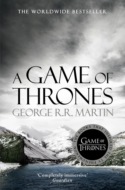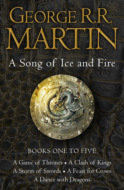Książki nie można pobrać jako pliku, ale można ją czytać w naszej aplikacji lub online na stronie.
Czytaj książkę: «A Song of Ice and Fire»
FIRE & BLOOD

George R.R. Martin

Copyright
HarperVoyager
An imprint of HarperCollinsPublishers Ltd
1 London Bridge Street
London SE1 9GF
First published in Great Britain by HarperCollinsPublishers 2018
This revised ebook edition 2020
Copyright © WO & Shade LLC 2018
Illustrations copyright © Penguin Random House LLC 2018, 2020
Interview copyright © WO & Shade LLC and Daniel Jones 2019
Cover illustration © Larry Rostant
Cover design by Claire Ward © HarperCollinsPublishers Ltd 2018
George R.R. Martin asserts the moral right to be identified as the author of this work.
Portions of this book were previously published, some in an abridged form, as:
‘Conquest’, published in The World of Ice and Fire by George R.R. Martin, Elio M. García, Jr., and Linda Antonsson, copyright © WO & Shade LLC 2014;
‘The Sons of the Dragon’, published in The Book of Swords (edited by Gardner Dozois), copyright © WO & Shade LLC 2017;
‘The Princess and the Queen’, published in Dangerous Women (edited by George R.R. Martin and Gardner Dozois), copyright © George R.R. Martin and Gardner Dozois 2013;
‘The Rogue Prince’, published in Rogues (edited by George R.R. Martin and Gardner Dozois), copyright © George R.R. Martin and Gardner Dozois 2014.
A catalogue copy of this book is available from the British Library.
This novel is entirely a work of fiction. The names, characters and incidents portrayed in it are the work of the author’s imagination. Any resemblance to actual persons, living or dead, events or localities is entirely coincidental.
All rights reserved under International and Pan-American Copyright Conventions. By payment of the required fees, you have been granted the non-exclusive, non-transferable right to access and read the text of this e-book on screen. No part of this text may be reproduced, transmitted, down-loaded, decompiled, reverse engineered, or stored in or introduced into any information storage and retrieval system, in any form or by any means, whether electronic or mechanical, now known or hereinafter invented, without the express written permission of HarperCollins.
Source ISBN: 9780008402785
Ebook Edition © October 2018 ISBN: 9780008295578
Version: 2020-06-23
Dedication
for Lenore, Elias, Andrea, and Sid, the Mountain Minions
Contents
Cover
Title Page
Copyright
Dedication
Aegon’s Conquest
Reign of the Dragon—The Wars of King Aegon I
Three Heads Had the Dragon—Governance Under King Aegon I
The Sons of the Dragon
Prince into King—The Ascension of Jaehaerys I
The Year of the Three Brides—49 AC
A Surfeit of Rulers
A Time of Testing—The Realm Remade
Birth, Death, and Betrayal Under King Jaehaerys I
Jaehaerys and Alysanne—Their Triumphs and Tragedies
The Long Reign—Jaehaerys and Alysanne: Policy, Progeny, and Pain
Heirs of the Dragon—A Question of Succession
The Dying of the Dragons—The Blacks and the Greens
The Dying of the Dragons—A Son for a Son
The Dying of the Dragons—The Red Dragon and the Gold
The Dying of the Dragons—Rhaenyra Triumphant
The Dying of the Dragons—Rhaenyra Overthrown
The Dying of the Dragons—The Short, Sad Reign of Aegon II
Aftermath—The Hour of the Wolf
Under the Regents—The Hooded Hand
Under the Regents—War and Peace and Cattle Shows
Under the Regents—The Voyage of Alyn Oakenfist
The Lysene Spring and the End of Regency
Lineages and Family Tree
A Conversation Between George R.R. Martin and Dan Jones
Footnotes
About the Author
About the Illustrator
By George R.R. Martin
About the Publisher

Fire & Blood
Being a History of the Targaryen Kings of Westeros

Volume One
from Aegon I (the Conqueror)
to
the Regency of Aegon III (the Dragonbane)
by Archmaester Gyldayn
of the Citadel of Oldtown
(here transcribed by George R.R. Martin)
Aegon’s Conquest
The maesters of the Citadel who keep the histories of Westeros have used Aegon’s Conquest as their touchstone for the past three hundred years. Births, deaths, battles, and other events are dated either AC (After the Conquest) or BC (Before the Conquest).
True scholars know that such dating is far from precise. Aegon Targaryen’s conquest of the Seven Kingdoms did not take place in a single day. More than two years passed between Aegon’s landing and his Oldtown coronation … and even then the Conquest remained incomplete, since Dorne remained unsubdued. Sporadic attempts to bring the Dornishmen into the realm continued all through King Aegon’s reign and well into the reigns of his sons, making it impossible to fix a precise end date for the Wars of Conquest.
Even the start date is a matter of some misconception. Many assume, wrongly, that the reign of King Aegon I Targaryen began on the day he landed at the mouth of the Blackwater Rush, beneath the three hills where the city of King’s Landing would eventually stand. Not so. The day of Aegon’s Landing was celebrated by the king and his descendants, but the Conqueror actually dated the start of his reign from the day he was crowned and anointed in the Starry Sept of Oldtown by the High Septon of the Faith. This coronation took place two years after Aegon’s Landing, well after all three of the major battles of the Wars of Conquest had been fought and won. Thus it can be seen that most of Aegon’s actual conquering took place from 2–1 BC, Before the Conquest.
The Targaryens were of pure Valyrian blood, dragonlords of ancient lineage. Twelve years before the Doom of Valyria (114 BC), Aenar Targaryen sold his holdings in the Freehold and the Lands of the Long Summer, and moved with all his wives, wealth, slaves, dragons, siblings, kin, and children to Dragonstone, a bleak island citadel beneath a smoking mountain in the narrow sea.
At its apex Valyria was the greatest city in the known world, the center of civilization. Within its shining walls, twoscore rival houses vied for power and glory in court and council, rising and falling in an endless, subtle, oft savage struggle for dominance. The Targaryens were far from the most powerful of the dragonlords, and their rivals saw their flight to Dragonstone as an act of surrender, as cowardice. But Lord Aenar’s maiden daughter Daenys, known forever afterward as Daenys the Dreamer, had foreseen the destruction of Valyria by fire. And when the Doom came twelve years later, the Targaryens were the only dragonlords to survive.
Dragonstone had been the westernmost outpost of Valyrian power for two centuries. Its location athwart the Gullet gave its lords a stranglehold on Blackwater Bay and enabled both the Targaryens and their close allies, the Velaryons of Driftmark (a lesser house of Valyrian descent) to fill their coffers off the passing trade. Velaryon ships, along with those of another allied Valyrian house, the Celtigars of Claw Isle, dominated the middle reaches of the narrow sea, whilst the Targaryens ruled the skies with their dragons.
Yet even so, for the best part of a hundred years after the Doom of Valyria (the rightly named Century of Blood), House Targaryen looked east, not west, and took little interest in the affairs of Westeros. Gaemon Targaryen, brother and husband to Daenys the Dreamer, followed Aenar the Exile as Lord of Dragonstone, and became known as Gaemon the Glorious. Gaemon’s son Aegon and his daughter Elaena ruled together after his death. After them the lordship passed to their son Maegon, his brother Aerys, and Aerys’s sons, Aelyx, Baelon, and Daemion. The last of the three brothers was Daemion, whose son Aerion then succeeded to Dragonstone.
The Aegon who would be known to history as Aegon the Conqueror and Aegon the Dragon was born on Dragonstone in 27 BC. He was the only son, and second child, of Aerion, Lord of Dragonstone, and Lady Valaena of House Velaryon, herself half Targaryen on her mother’s side. Aegon had two trueborn siblings; an elder sister, Visenya, and a younger sister, Rhaenys. It had long been the custom amongst the dragonlords of Valyria to wed brother to sister, to keep the bloodlines pure, but Aegon took both his sisters to bride. By tradition, he would have been expected to wed only his older sister, Visenya; the inclusion of Rhaenys as a second wife was unusual, though not without precedent. It was said by some that Aegon wed Visenya out of duty and Rhaenys out of desire.
All three siblings had shown themselves to be dragonlords before they wed. Of the five dragons who had flown with Aenar the Exile from Valyria, only one survived to Aegon’s day: the great beast called Balerion, the Black Dread. The dragons Vhagar and Meraxes were younger, hatched on Dragonstone itself.
A common myth, oft heard amongst the ignorant, claims that Aegon Targaryen had never set foot upon the soil of Westeros until the day he set sail to conquer it, but this cannot be truth. Years before that sailing, the Painted Table had been carved and decorated at Lord Aegon’s command; a massive slab of wood, some fifty feet long, carved in the shape of Westeros, and painted to show all the woods and rivers and towns and castles of the Seven Kingdoms. Plainly, Aegon’s interest in Westeros long predated the events that drove him to war. As well, there are reliable reports of Aegon and his sister Visenya visiting the Citadel of Oldtown in their youth, and hawking on the Arbor as guests of Lord Redwyne. He may have visited Lannisport as well; accounts differ.
The Westeros of Aegon’s youth was divided into seven quarrelsome kingdoms, and there was hardly a time when two or three of these kingdoms were not at war with one another. The vast, cold, stony North was ruled by the Starks of Winterfell. In the deserts of Dorne, the Martell princes held sway. The gold-rich westerlands were ruled by the Lannisters of Casterly Rock, the fertile Reach by the Gardeners of Highgarden. The Vale, the Fingers, and the Mountains of the Moon belonged to House Arryn … but the most belligerent kings of Aegon’s time were the two whose realms lay closest to Dragonstone, Harren the Black and Argilac the Arrogant.
From their great citadel, Storm’s End, the Storm Kings of House Durrandon had once ruled the eastern half of Westeros, from Cape Wrath to the Bay of Crabs, but their powers had been dwindling for centuries. The Kings of the Reach had nibbled at their domains from the west, the Dornishmen harassed them from the south, and Harren the Black and his ironmen had pushed them from the Trident and the lands north of the Blackwater Rush. King Argilac, last of the Durrandon, had arrested this decline for a time, turning back a Dornish invasion whilst still a boy, crossing the narrow sea to join the great alliance against the imperialist “tigers” of Volantis, and slaying Garse VII Gardener, King of the Reach, in the Battle of Summerfield twenty years later. But Argilac had grown older; his famous mane of black hair had gone grey, and his prowess at arms had faded.
North of the Blackwater, the riverlands were ruled by the bloody hand of Harren the Black of House Hoare, King of the Isles and the Rivers. Harren’s ironborn grandsire, Harwyn Hardhand, had taken the Trident from Argilac’s grandsire, Arrec, whose own forebears had thrown down the last of the river kings centuries earlier. Harren’s father had extended his domains east to Duskendale and Rosby. Harren himself had devoted most of his long reign, close on forty years, to building a gigantic castle beside the Gods Eye, but with Harrenhal at last nearing completion, the ironborn would soon be free to seek fresh conquests.
No king in Westeros was more feared than Black Harren, whose cruelty had become legendary all through the Seven Kingdoms. And no king in Westeros felt more threatened than Argilac the Storm King, last of the Durrandon, an aging warrior whose only heir was his maiden daughter. Thus it was that King Argilac reached out to the Targaryens on Dragonstone, offering Lord Aegon his daughter in marriage, with all the lands east of the Gods Eye from the Trident to the Blackwater Rush as her dowry.
Aegon Targaryen spurned the Storm King’s proposal. He had two wives, he pointed out; he did not need a third. And the dower lands being offered had belonged to Harrenhal for more than a generation. They were not Argilac’s to give. Plainly, the aging Storm King meant to establish the Targaryens along the Blackwater as a buffer between his own lands and those of Harren the Black.
The Lord of Dragonstone countered with an offer of his own. He would take the dower lands being offered if Argilac would also cede Massey’s Hook and the woods and plains from the Blackwater south to the river Wendwater and the headwaters of the Mander. The pact would be sealed by the marriage of Argilac’s daughter to Orys Baratheon, Lord Aegon’s childhood friend and champion.
These terms Argilac the Arrogant rejected angrily. Orys Baratheon was a baseborn half-brother to Lord Aegon, it was whispered, and the Storm King would not dishonor his daughter by giving her hand to a bastard. The very suggestion enraged him. Argilac had the hands of Aegon’s envoy cut off and returned to him in a box. “These are the only hands your bastard shall have of me,” he wrote.
Aegon made no reply. Instead he summoned his friends, bannermen, and principal allies to attend him on Dragonstone. Their numbers were small. The Velaryons of Driftmark were sworn to House Targaryen, as were the Celtigars of Claw Isle. From Massey’s Hook came Lord Bar Emmon of Sharp Point and Lord Massey of Stonedance, both sworn to Storm’s End, but with closer ties to Dragonstone. Lord Aegon and his sisters took counsel with them, and visited the castle sept to pray to the Seven of Westeros as well, though he had never before been accounted a pious man.
On the seventh day, a cloud of ravens burst from the towers of Dragonstone to bring Lord Aegon’s word to the Seven Kingdoms of Westeros. To the seven kings they flew, to the Citadel of Oldtown, to lords both great and small. All carried the same message: from this day forth there would be but one king in Westeros. Those who bent the knee to Aegon of House Targaryen would keep their lands and titles. Those who took up arms against him would be thrown down, humbled, and destroyed.
Accounts differ on how many swords set sail from Dragonstone with Aegon and his sisters. Some say three thousand; others number them only in the hundreds. This modest Targaryen host put ashore at the mouth of the Blackwater Rush, on the northern bank where three wooded hills rose above a small fishing village.
In the days of the Hundred Kingdoms, many petty kings had claimed dominion over the river mouth, amongst them the Darklyn kings of Duskendale, the Masseys of Stonedance, and the river kings of old, be they Mudds, Fishers, Brackens, Blackwoods, or Hooks. Towers and forts had crowned the three hills at various times, only to be thrown down in one war or another. Now only broken stones and overgrown ruins remained to welcome the Targaryens. Though claimed by both Storm’s End and Harrenhal, the river mouth was undefended, and the closest castles were held by lesser lords of no great power or military prowess, and lords moreover who had little reason to love their nominal overlord, Harren the Black.
Aegon Targaryen quickly threw up a log-and-earth palisade around the highest of the three hills, and dispatched his sisters to secure the submission of the nearest castles. Rosby yielded to Rhaenys and golden-eyed Meraxes without a fight. At Stokeworth a few crossbowmen loosed bolts at Visenya, until Vhagar’s flames set the roofs of the castle keep ablaze. Then they too submitted.
The Conquerors’ first true test came from Lord Darklyn of Duskendale and Lord Mooton of Maidenpool, who joined their power and marched south with three thousand men to drive the invaders back into the sea. Aegon sent Orys Baratheon out to attack them on the march, whilst he descended on them from above with the Black Dread. Both lords were slain in the one-sided battle that followed; Darklyn’s son and Mooton’s brother thereafter yielded up their castles and swore their swords to House Targaryen. At that time Duskendale was the principal Westerosi port on the narrow sea, and had grown fat and wealthy from the trade that passed through its harbor. Visenya Targaryen did not allow the town to be sacked, but she did not hesitate to claim its riches, greatly swelling the coffers of the Conquerors.
This perhaps would be an apt place to discuss the differing characters of Aegon Targaryen and his sisters and queens.
Visenya, eldest of the three siblings, was as much a warrior as Aegon himself, as comfortable in ringmail as in silk. She carried the Valyrian longsword Dark Sister, and was skilled in its use, having trained beside her brother since childhood. Though possessed of the silver-gold hair and purple eyes of Valyria, hers was a harsh, austere beauty. Even those who loved her best found Visenya stern, serious, and unforgiving; some said that she played with poisons and dabbled in dark sorceries.
Rhaenys, youngest of the three Targaryens, was all her sister was not, playful, curious, impulsive, given to flights of fancy. No true warrior, Rhaenys loved music, dancing, and poetry, and supported many a singer, mummer, and puppeteer. Yet it was said that Rhaenys spent more time on dragonback than her brother and sister combined, for above all things she loved to fly. She once was heard to say that before she died she meant to fly Meraxes across the Sunset Sea to see what lay upon its western shores. Whilst no one ever questioned Visenya’s fidelity to her brother-husband, Rhaenys surrounded herself with comely young men, and (it was whispered) even entertained some in her bedchambers on the nights when Aegon was with her elder sister. Yet despite these rumors, observers at court could not fail to note that the king spent ten nights with Rhaenys for every night with Visenya.
Aegon Targaryen himself, strangely, was as much an enigma to his contemporaries as to us. Armed with the Valyrian steel blade Blackfyre, he was counted amongst the greatest warriors of his age, yet he took no pleasure in feats of arms, and never rode in tourney or melee. His mount was Balerion the Black Dread, but he flew only to battle or to travel swiftly across land and sea. His commanding presence drew men to his banners, yet he had no close friends, save Orys Baratheon, the companion of his youth. Women were drawn to him, but Aegon remained ever faithful to his sisters. As king, he put great trust in his small council and his sisters, leaving much of the day-to-day governance of the realm to them … yet did not hesitate to take command when he found it necessary. Though he dealt harshly with rebels and traitors, he was open-handed with former foes who bent the knee.
This he showed for the first time at the Aegonfort, the crude wood-and-earth castle he had raised atop what would henceforth and forever be known as Aegon’s High Hill. Having taken a dozen castles and secured the mouth of the Blackwater Rush on both sides of the river, he commanded the lords he had defeated to attend him. There they laid their swords at his feet, and Aegon raised them up and confirmed them in their lands and titles. To his oldest supporters he gave new honors. Daemon Velaryon, Lord of the Tides, was made master of ships, in command of the royal fleet. Triston Massey, Lord of Stonedance, was named master of laws, Crispian Celtigar master of coin. And Orys Baratheon he proclaimed to be “my shield, my stalwart, my strong right hand.” Thus Baratheon is reckoned by the maesters the first King’s Hand.
Heraldic banners had long been a tradition amongst the lords of Westeros, but such had never been used by the dragonlords of old Valyria. When Aegon’s knights unfurled his great silken battle standard, with a red three-headed dragon breathing fire upon a black field, the lords took it for a sign that he was now truly one of them, a worthy high king for Westeros. When Queen Visenya placed a Valyrian steel circlet, studded with rubies, on her brother’s head and Queen Rhaenys hailed him as, “Aegon, First of His Name, King of All Westeros, and Shield of His People,” the dragons roared and the lords and knights sent up a cheer … but the smallfolk, the fishermen and fieldhands and goodwives, shouted loudest of all.
The seven kings that Aegon the Dragon meant to uncrown were not cheering, however. In Harrenhal and Storm’s End, Harren the Black and Argilac the Arrogant had already called their banners. In the west, King Mern of the Reach rode the ocean road north to Casterly Rock to meet with King Loren of House Lannister. The Princess of Dorne dispatched a raven to Dragonstone, offering to join Aegon against Argilac the Storm King … but as an equal and ally, not a subject. Another offer of alliance came from the boy king of the Eyrie, Ronnel Arryn, whose mother asked for all the lands east of the Green Fork of the Trident for the Vale’s support against Black Harren. Even in the North, King Torrhen Stark of Winterfell sat with his lords bannermen and counselors late into the night, discussing what was to be done about this would-be conqueror. The whole realm waited anxiously to see where Aegon would move next.
Within days of his coronation, Aegon’s armies were on the march again. The greater part of his host crossed the Blackwater Rush, making south for Storm’s End under the command of Orys Baratheon. Queen Rhaenys accompanied him, astride Meraxes of the golden eyes and silver scales. The Targaryen fleet, under Daemon Velaryon, left Blackwater Bay and turned north, for Gulltown and the Vale. With them went Queen Visenya and Vhagar. The king himself marched northwest, to the Gods Eye and the newly completed Harrenhal, the gargantuan fortress that was the pride and obsession of King Harren the Black.

All three of the Targaryen thrusts faced fierce opposition. Lords Errol, Fell, and Buckler, bannermen to Storm’s End, surprised the advance elements of Orys Baratheon’s host as they were crossing the Wendwater, cutting down more than a thousand men before fading back into the trees. A hastily assembled Arryn fleet, augmented by a dozen Braavosi warships, met and defeated the Targaryen fleet in the waters off Gulltown. Amongst the dead was Aegon’s admiral, Daemon Velaryon. Aegon himself was attacked on the south shore of the Gods Eye, not once but twice. The Battle of the Reeds was a Targaryen victory, but they suffered heavy losses at the Wailing Willows when two of King Harren’s sons crossed the lake in longboats with muffled oars and fell upon their rear.
In the end, though, Aegon’s enemies had no answer for his dragons. The men of the Vale sank a third of the Targaryen ships and captured near as many, but when Queen Visenya descended upon them from the sky, their own ships burned. Lords Errol, Fell, and Buckler hid in their familiar forests until Queen Rhaenys unleashed Meraxes and a wall of fire swept through the woods, turning the trees to torches. And the victors at the Wailing Willows, returning across the lake to Harrenhal, were ill prepared when Balerion fell upon them out of the morning sky. Harren’s longboats burned. So did Harren’s sons.
Aegon’s foes also found themselves plagued by other enemies. As Argilac the Arrogant gathered his swords at Storm’s End, pirates from the Stepstones descended on the shores of Cape Wrath to take advantage of their absence, and Dornish raiding parties came boiling out of the Red Mountains to sweep across the marches. In the Vale, young King Ronnel had to contend with a rebellion on the Three Sisters, when the Sistermen renounced all allegiance to the Eyrie and proclaimed Lady Marla Sunderland their queen.
Yet these were but minor vexations compared to what befell Harren the Black. Though House Hoare had ruled the riverlands for three generations, the men of the Trident had no love for their ironborn overlords. Harren the Black had driven thousands to their deaths in the building of his great castle of Harrenhal, plundering the riverlands for materials, and beggaring lords and smallfolk alike with his appetite for gold. So now the riverlands rose against him, led by Lord Edmyn Tully of Riverrun. Summoned to the defense of Harrenhal, Tully declared for House Targaryen instead, raised the dragon banner over his castle, and rode forth with his knights and archers to join his strength to Aegon’s. His defiance gave heart to the other riverlords. One by one, the lords of the Trident renounced Harren and declared for Aegon the Dragon. Blackwoods, Mallisters, Vances, Brackens, Pipers, Freys, Strongs … summoning their levies, they descended on Harrenhal.
Suddenly outnumbered, King Harren the Black took refuge in his supposedly impregnable stronghold. The largest castle ever raised in Westeros, Harrenhal boasted five gargantuan towers, an inexhaustible source of fresh water, huge subterranean vaults well stocked with provisions, and massive walls of black stone higher than any ladder and too thick to be broken by any ram or shattered by a trebuchet. Harren barred his gates and settled down with his remaining sons and supporters to withstand a siege.
Aegon of Dragonstone was of a different mind. Once he had joined his power with that of Edmyn Tully and the other riverlords to ring the castle, he sent a maester to the gates under a peace banner, to parley. Harren emerged to meet him; an old man and grey, yet still fierce in his black armor. Each king had his banner bearer and his maester in attendance, so the words that they exchanged are still remembered.
“Yield now,” Aegon began, “and you may remain as Lord of the Iron Islands. Yield now, and your sons will live to rule after you. I have eight thousand men outside your walls.”
“What is outside my walls is of no concern to me,” said Harren. “Those walls are strong and thick.”
“But not so high as to keep out dragons. Dragons fly.”
“I built in stone,” said Harren. “Stone does not burn.”
To which Aegon said, “When the sun sets, your line shall end.”
It is said that Harren spat at that and returned to his castle. Once inside, he sent every man of his to the parapets, armed with spears and bows and crossbows, promising lands and riches to whichever of them could bring the dragon down. “Had I a daughter, the dragonslayer could claim her hand as well,” Harren the Black proclaimed. “Instead I will give him one of Tully’s daughters, or all three if he likes. Or he may pick one of Blackwood’s whelps, or Strong’s, or any girl born of these traitors of the Trident, these lords of yellow mud.” Then Harren the Black retired to his tower, surrounded by his household guard, to sup with his remaining sons.
As the last light of the sun faded, Black Harren’s men stared into the gathering darkness, clutching their spears and crossbows. When no dragon appeared, some may have thought that Aegon’s threats had been hollow. But Aegon Targaryen took Balerion up high, through the clouds, up and up until the dragon was no bigger than a fly upon the moon. Only then did he descend, well inside the castle walls. On wings as black as pitch Balerion plunged through the night, and when the great towers of Harrenhal appeared beneath him, the dragon roared his fury and bathed them in black fire, shot through with swirls of red.
Stone does not burn, Harren had boasted, but his castle was not made of stone alone. Wood and wool, hemp and straw, bread and salted beef and grain, all took fire. Nor were Harren’s ironmen made of stone. Smoking, screaming, shrouded in flames, they ran across the yards and tumbled from the wallwalks to die upon the ground below. And even stone will crack and melt if a fire is hot enough. The riverlords outside the castle walls said later that the towers of Harrenhal glowed red against the night, like five great candles … and like candles, they began to twist and melt as runnels of molten stone ran down their sides.
Harren and his last sons died in the fires that engulfed his monstrous fortress that night. House Hoare died with him, and so too did the Iron Islands’ hold on the riverlands. The next day, outside the smoking ruins of Harrenhal, King Aegon accepted an oath of fealty from Edmyn Tully, Lord of Riverrun, and named him Lord Paramount of the Trident. The other riverlords did homage as well, to Aegon as king and to Edmyn Tully as their liege lord. When the ashes had cooled enough to allow men to enter the castle safely, the swords of the fallen, many shattered or melted or twisted into ribbons of steel by dragonfire, were gathered up and sent back to the Aegonfort in wagons.
South and east, the Storm King’s bannermen proved considerably more loyal than King Harren’s. Argilac the Arrogant gathered a great host about him at Storm’s End. The seat of the Durrandons was a mighty fastness, its great curtain wall even thicker than the walls of Harrenhal. It too was thought to be impregnable to assault. Word of King Harren’s end soon reached the ears of his old enemy King Argilac, however. Lords Fell and Buckler, falling back before the approaching host (Lord Errol had been killed), had sent him word of Queen Rhaenys and her dragon. The old warrior king roared that he did not intend to die as Harren had, cooked inside his own castle like a suckling pig with an apple in his mouth. No stranger to battle, he would decide his own fate, sword in hand. So Argilac the Arrogant rode forth from Storm’s End one last time, to meet his foes in the open field.
